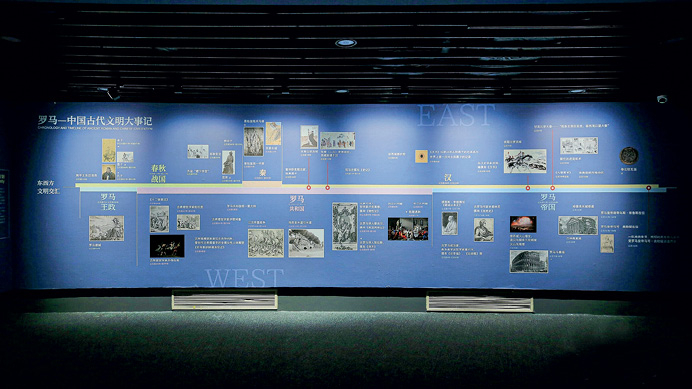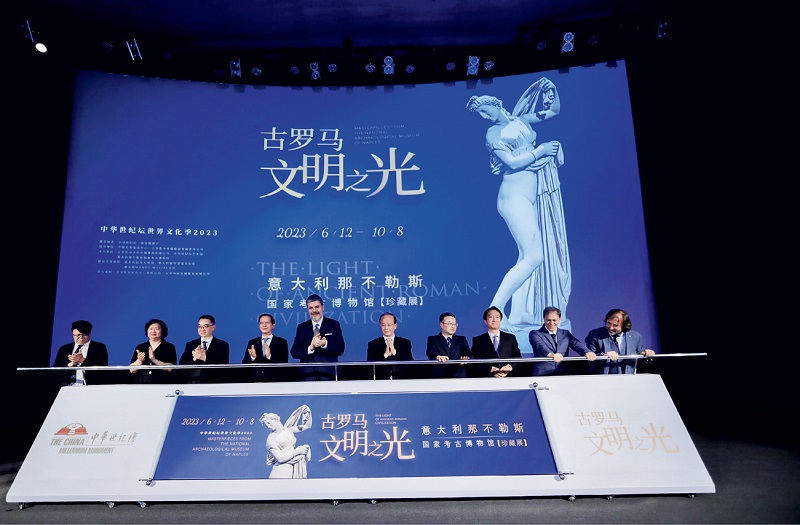China and Italy are thousands of miles apart but they were connected as early as in the first and second century BC by the ancient Silk Road. With the modern version of the historical trade route, the Belt and Road Initiative (BRI), celebrating its 10th anniversary this year, the cultural bond between the two countries is continuing to grow.
“The Light of Ancient Roman Civilization: Masterpieces from the National Archaeological Museum of Naples,” a traveling exhibition displaying sculptures, frescoes, bronze relics, and other artifacts from ancient Rome, came to China this year. After a curtain-raiser in Shanghai, it opened at the Beijing World Art Museum of the China Millennium Monument in June, closing on October 8.
During this period, a night tour was organized for culture lovers where Italian officials added their expertise.
Federico Roberto Antonelli, cultural counselor at the Italian embassy in China and director of the Italian Cultural Institute in Beijing, explained that the National Archaeological Museum of Naples is one of the oldest and most famous museums in Italy. Built in the late 18th century, it is renowned for its vast collection of ancient Roman art heritage items. The 69 objects of art at the exhibition have a special significance because of their provenance. They were all unearthed in Heculaneum and Pompeii, two doomed cities that were destroyed by the erupting Mount Vesuvius in 79 AD.

Italian Ambassador to China, Massimo Ambrosetti, is taking a look at the creative products blended with China-Italy cultural elements at the Beijing World Art Museum of the China Millennium Monument on June 12, 2023.
Going Beyond Time and Space
Antonelli said that the exhibition takes viewers on a breath-taking journey through time and space to witness the colorful life of ancient Romans. “What we see in Western museums are often pure white marble sculptures. However, in reality, these sculptures were originally painted with rich colors, which were commonly seen in Roman daily life,” he said.
The National Archaeological Museum houses over three million items. Despite the destruction of the bustling Pompeii and its neighboring coastal city Heculaneum during the volcanic eruption, the massive accumulation of volcanic ash preserved the ruins of the two cities, providing rich research materials for archaeologists and historians.
The exhibition included the Chronology and Timeline of Ancient Roman and Chinese Civilization drawn on an entire wall, which showed that all the displayed artworks were created in the Roman Empire around the first and second century, a period whose aesthetic concepts and principles were to exert a far-reaching influence on subsequent generations. When the epic works of art showcasing the Mediterranean civilization were created, China was under the reign of the Han Dynasty (206 BC-AD 220). The ancient trade route upon which goods and ideas were carried between the two great civilizations of Rome and China was known as the Silk Road.
Italian archaeologist Mario Grimaldi, who curated the exhibition, explained the objective behind the China tour: “We hope to build a bridge for exchange and mutual learning between the two ancient civilizations of the East and the West. Through this exhibition, we can connect the society and civilization of ancient Rome with that of ancient China. This will help Chinese and Italian audiences better understand two different social systems, two different power structures, and the different manifestations of power in both societies.”
Grimaldi added that alongside statues of Roman emperors and deities, the exhibition also provided a perspective on ordinary people’s daily life during that historical period through murals of ancient Roman residences, and the objects they used in their daily lives like utensils.

The exhibition “The Light of Ancient Roman Civilization: Masterpieces from the National Archaeological Museum of Naples” includes the Chronology and Timeline of Ancient Roman and Chinese Civilization displayed on the wall.
Bonding through Museum Exchanges
The Chinese have a saying, “Even mountains and seas cannot distance people with common aspirations,” which also describes the relationship between China and Italy, two countries with a long friendship. Antonelli said, “In today’s complex international situation, cultural exchanges and cooperation are more necessary than ever as they are not only a source of inspiration, but also an important way to understand the basic values of different countries.” Museum exchanges between China and Italy can promote mutual learning between civilizations, strengthen bonds between peoples, and inject new vitality into Italy-China ties.
Italy, the birthplace of the ancient Roman civilization and the cradle of the Renaissance, has inspired more than a dozen Italy-themed exhibitions curated by the Italian Cultural Institute in Beijing, Shanghai, and other Chinese cities. Besides “The Light of Ancient Roman Civilization,” self-portraits of famous artists from Italy’s Uffizi Gallery were on display at the National Museum of China in Beijing and later in the city of Chengdu, while Raffles City Beijing showcased the “Centenary Triptych,” which celebrates the centenary of three immortal Italian maestros: Leonardo da Vinci, Raphael, and Dante.
The exhibitions enriched ancient classics with modern innovations of science and technology. For example, the National Museum of China used a specially designed light and shadow technique based on holography for the portraits to recreate them in digital high-definition, making them lifelike. The application of new modern technology is meant to break down the barriers of time and space and create a platform for dialogue in history, culture, humanities and technology. It is also a means to present artists from all over the world to audiences worldwide and promote cultural exchanges.
“Both China and Italy created splendid civilizations during the long span of human history, and a wealth of spiritual and cultural heritage,” Antonelli said. “Italy draws inspiration from its unique cultural identity and sends a strong message to China of conducting cross-cultural collaboration and dialogues in the cultural sector. We firmly believe that art and culture are universal languages that can bring diverse civilizations, countries and people closer.”

The exhibition of Museum of Naples kicks off at the Beijing World Art Museum of the China Millennium Monument on June 12, 2023.
Illuminating the Future
China and Italy exemplify the Eastern and Western civilizations respectively, with both contributing to human progress. As countries with the largest number of UNESCO world heritage sites, they have enviable cultural and tourism resources.
Ahead of his state visit to Italy in 2019, Chinese President Xi Jinping wrote in a signed article published in the Italian media, “We encourage our world heritage sites to forge twinning relationships and our cultural institutions and individuals to organize premium relic and art exhibitions. We also encourage joint production of films and TV programs, the teaching of each other’s languages, as well as more mutual travel and visits. Through these exchanges, we will make new contributions to the diversity of civilizations and mutual learning between different cultures.”
According to data from the Italian National Institute of Statistics, in 2019, Italy received over five million Chinese tourists, making it one of the European countries to receive the highest number of Chinese visitors that year. In 2020, Italy and China celebrated the 50th anniversary of their diplomatic ties and the China-Italy Year of Culture and Tourism was flagged off.
“Even in the face of the global pandemic, the 2020 China-Italy Year of Culture and Tourism was never interrupted. From 2020 to 2023, the two countries planned and organized various cultural activities, including performing arts, visual arts, cultural heritage, tourism and creative design,” Antonelli said.
The newly appointed Italian Ambassador to China, Massimo Ambrosetti, who began his China stint in May, emphasized the relations between Italy and China “can count on deep roots and an ancient friendship: a great heritage of dialogue and cooperation – between our countries, our peoples and our millennial civilizations – which we will continue to develop.”
Historical figures who were part of the friendly exchanges between the two countries in the past include Italian navigator Marco Polo (1254-1324), who came to China along the ancient Silk Road, and missionary Matteo Ricci (1552-1610), who brought Western geometry and geographical knowledge to China.
Next year will be the 700th anniversary of Marco Polo’s death. Ambrosetti said it will be an important occasion to underline that “our bilateral relations have been based for centuries on a model of peaceful contacts and mutual benefits.”